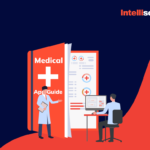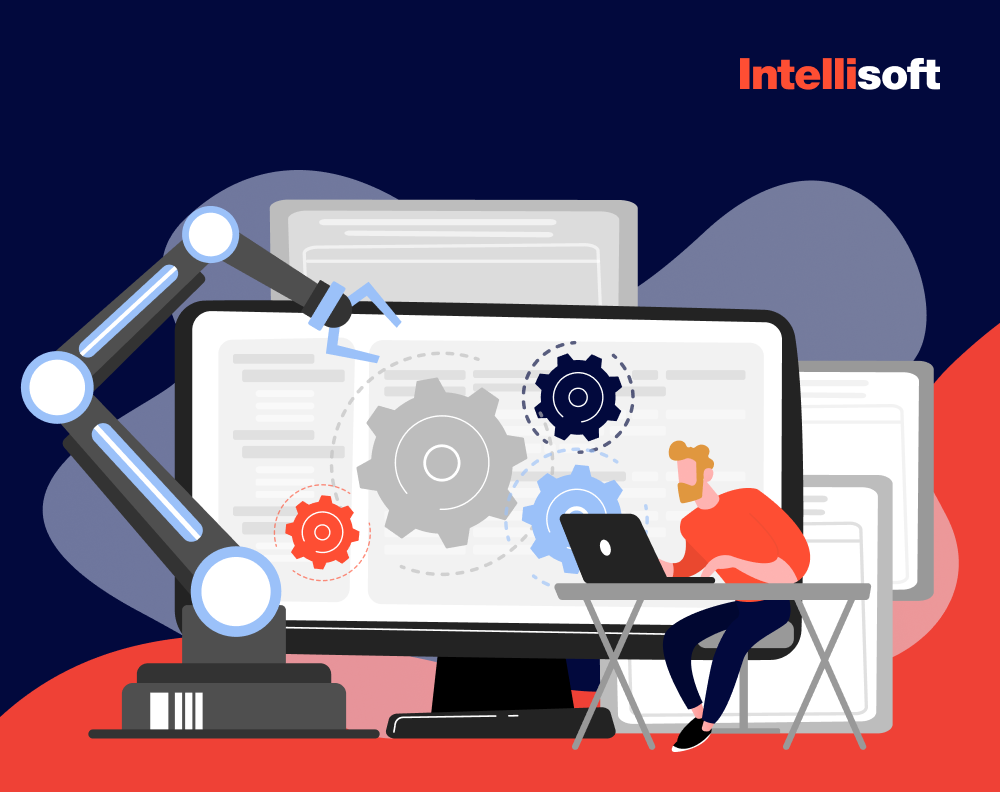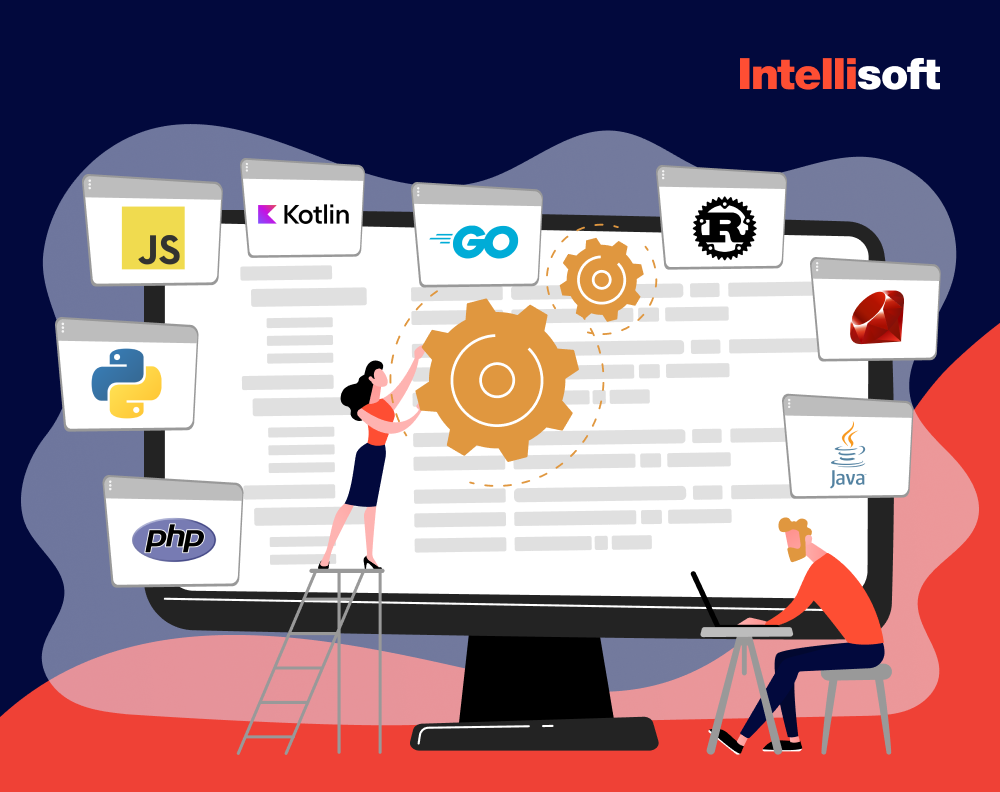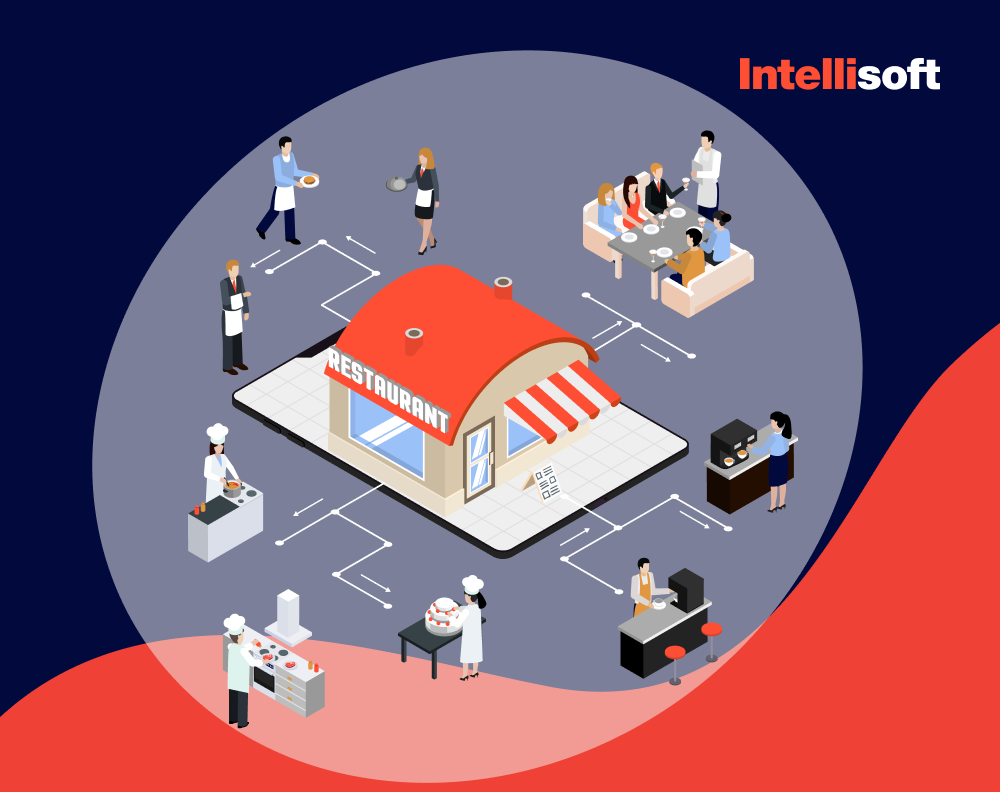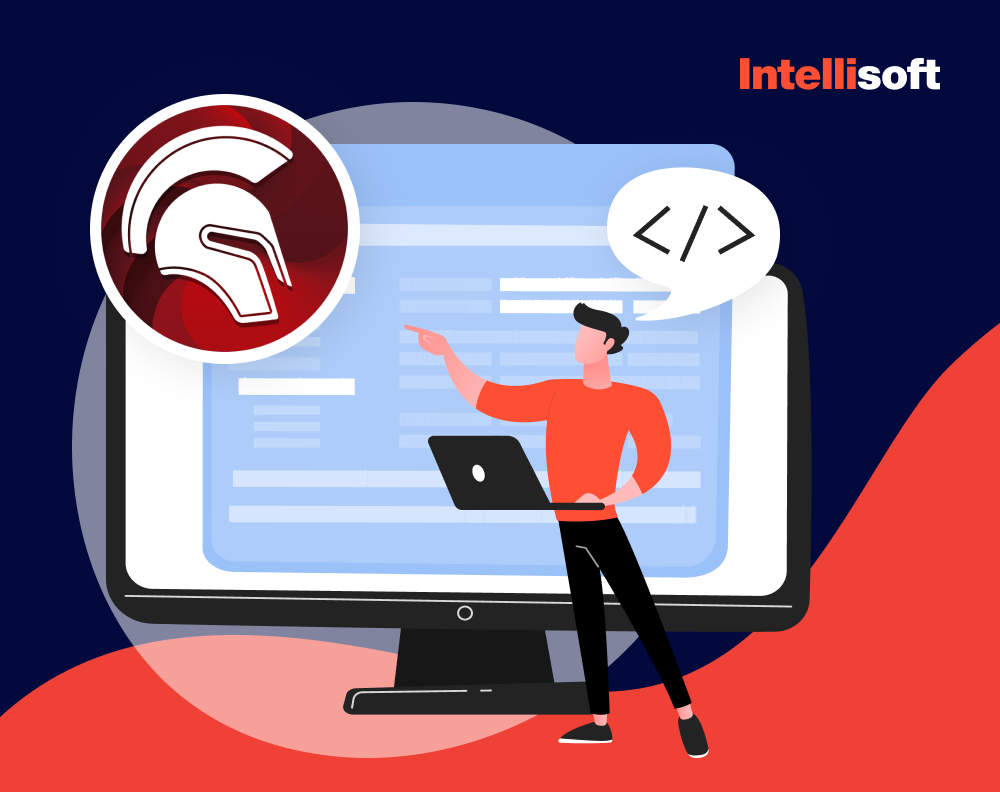Need Software Development Team?
Imagine a world without maps or compasses and no clear guidelines like the Milky Way helping you find the route to your destination. No one could ever travel far with intent and return bearing the fruits of the journey. Now you can imagine how software development team members would feel working without clearly understanding their goal and how to achieve it.

That is where the Product Requirements Document (PRD) comes in handy. PRD is a short but comprehensive guide for a technical team that explains what they need to do.
A Lean PRD is a streamlined and simplified variant of the classic PRD, which can often be bloated and difficult to understand. It focuses on the most critical aspects of the product, such as:
- Defining the problem
- Creating user stories
- Prioritizing features
- Testing assumptions
Simply no irrelevant details should appear in a lean PRD.
IntelliSoft has experience in the creation of Product Requirements Documents because we created a PRD for our ZyLAB project.
We created this article to help you explore the best practices for writing a Lean PRD and the challenges that product teams face when crafting this essential document. We will provide insights on overcoming those challenges for creating an effective Lean PRD and discuss how to ensure that the PRD remains current and aligned with the business goals.
By the end of this article, you will have a thorough understanding of a Lean PRD, how to create one, and how to use it to guide the product development process. Whether you are a product manager, designer, or engineer, a Lean PRD is an invaluable tool that can help you create products that fully meet the needs of your users and deliver value to your business.
Table of Contents
What is a Product Requirements Document?
Let’s say you’re embarking on a grand adventure – a quest to create the ultimate product that will change the world or an app that will mean the whole world to a specific group of users.
You’ve gathered a team of talented individuals with unique skills and perspectives, but how do you ensure everyone is on the same page? How do you envision your future product and ensure everyone works towards the same goal? The answer is in the Product Requirements Document. The top reason startups fail is that there is no market need for the product, so you must research and plan your further activities beforehand.
Definition of a Product Requirement Document
The PRD is the map that guides your team throughout the journey, the blueprint outlining your product’s features, functions, and requirements. It’s a document that captures the essence of your product and answers three questions:
- What is it?
- What does it do?
- Why does it matter?
In many ways, the PRD is like a short storybook – it tells the tale of your product from beginning to end. It starts with an introduction, setting the stage and introducing the main characters (in this case, your product and its users). It describes your product’s key features and functionalities and details the user experience. It then moves on to the plot, describing the problem your product solves and the challenges that users face without it. And finally, it concludes with a resolution – a clear guide for developers to create a successful product.
But the PRD is more than just a storybook. It’s a tool for collaboration, helping your team to communicate effectively and stay aligned. It’s a roadmap that guides your team toward the ultimate goal – creating a product that will make your business profitable and properly functioning.
In short, the PRD is the key to your product’s success, the compass guiding your team on this grand adventure, helping you navigate the twists and turns of product development.
What are the 4 Types of Product Requirements?
In the world of product development, four types of requirements are crucial to the success of your product. Each of these requirements serves a unique purpose, and together they form the foundation of your product’s design and development. So let’s explore them and discover how they work together to create a winning product.
- Functional requirements
First up, we have functional requirements. These are the bread and butter of your product – the features and functionalities that it must have to meet the needs of your users. They describe the user-facing features and capabilities that your product will offer and form the basis of the user experience. Functional requirements answer the question, “what does the product do?”
- Performance requirements
Next, we have performance requirements that focus on how well your product performs its functions. Performance requirements answer the question, “how well does the product do what it does?” They describe the metrics your product must meet to be successful, such as speed, accuracy, or capacity. Performance requirements ensure that your product not only works but works well.
- Technical requirements
Moving on, we have system technical requirements. These requirements focus on the underlying technology that powers your product. System technical requirements document answers the question, “how is the product built?” They describe the technical architecture, infrastructure, and platforms that your product relies on and ensure that the technology stack is robust, secure, and scalable.
- Specifications
Last but not least, we have specifications. These are the nitty-gritty details of your product’s design and development. Specifications answer the question, “how is the product made?” They describe the precise details of your product’s design, such as components, processes, and resources needed to build your product.
Together, these four categories of requirements form a comprehensive framework that guides your product’s development from start to finish. They ensure that you build your product on a solid technical foundation, and it not only meets the needs of your users but also performs well and meets the highest standards of quality.
What Is the Difference Between Traditional PRD and Lean PRD?
There are two main approaches to creating a Product Requirement Document: traditional and lean methods. While both aim to create a comprehensive roadmap for product development, the two have significant differences. So let’s explore what makes traditional PRD and lean PRD different.
First, we have a traditional PRD – a comprehensive, top-down approach to product development. Traditional PRD typically involves a lengthy and detailed document outlining every product aspect, from the user experience to the technical architecture. Developers often use traditional PRD to minimize risk and ensure all stakeholders align with the product’s vision and requirements.
On the other hand, a lean PRD is a minimalist, bottom-up approach to product development. Lean PRD focuses on validating assumptions and learning as much as possible about the user before investing in product development. Rather than creating a lengthy and detailed document, lean PRD involves creating a lightweight, iterative document that can evolve as the team learns more about the product and its users.
So what are the key differences between these two approaches? Firstly, traditional PRD is more comprehensive and detailed, while lean PRD is more iterative and flexible. Secondly, traditional PRD focuses on minimizing risk, while lean PRD focuses on learning as much as possible before investing in product development. Finally, traditional PRD is more top-down, while lean PRD is bottom-up.
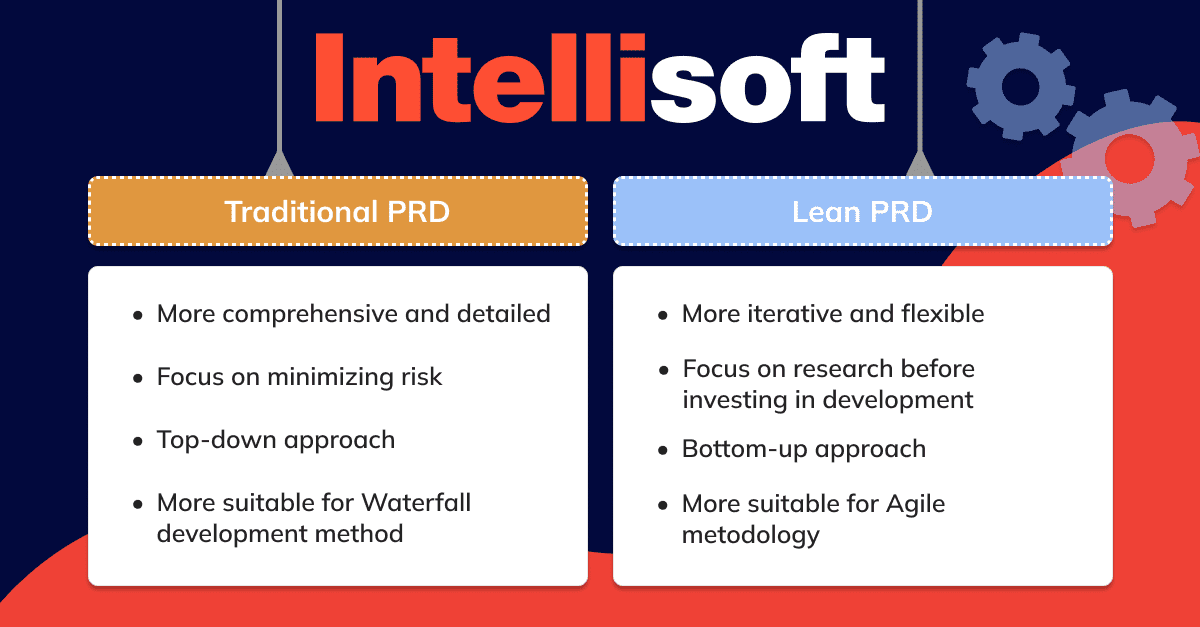
So which approach is right for your product? It depends on your team, your product, and your goals. Traditional PRD might be the right approach if you work on a complex, high-risk development with many stakeholders. However, lean PRD might be better if you’re working on a product with a smaller scope and fewer stakeholders. Ultimately, the key is to choose an approach that aligns with your team’s values and goals and allows you to create a product that meets the needs of your users.
What Should a Lean Product Requirements Document Contain?
Let’s explore what a Lean PRD should contain. What information should be in your focus at the very start of the project?
First and foremost, a Lean PRD should be minimalist. It should contain only the most essential data to guide product development, including:
- Product’s purpose
- Target audience
- Key features
- Technical requirements
- Design guidelines
- Timeline
The purpose of the product is the most critical element of the Lean PRD. It should clearly articulate why the product exists and what problem it solves for the customer. It helps ensure everyone on the team is working towards a common goal.
Next, a clear definition of the target audience. Who is the product for, and what are the users’ needs and desires? Understanding the target audience is essential for creating a product that resonates with them and meets their expectations.
A Lean PRD should focus on the most critical elements to deliver the most value to the customer. It means prioritizing features that align with the product’s purpose and target audience. Once you establish the purpose and target audience, it’s time to identify the product’s key features.
In addition to these core elements, a Lean PRD may contain other important information, such as technical requirements, design guidelines, and project timelines. However, these elements should be kept to a minimum and only included if necessary.
What Should a Traditional Product Requirements Document Contain?
Let’s look at what to include in a traditional PRD. The documents should contain:
- Appropriate document metadata to help track changes
- Clear problem statement — what the product should help solve
- Customer or market research
- A link to the MRD
- List of all the agreed product capabilities, features, and functionality
- Statement on what wouldn’t be included in the release
- Potential for future upgrades
- System and environment requirements
- List of assumptions and obstacles
- Acceptance criteria (functionality, usability, reliability, performance)
- Definition of success metrics (DoD)
- Goal release timeline
A traditional product requirements document should contain all the necessary information for a successful product development process. It is crucial to keep the PRD as comprehensive as possible to avoid misunderstandings and ensure everyone on the team is on the same page.
Key Elements of a Lean PRD
A Lean PRD focuses on learning as much as possible about the user before investing in development. Before finalizing the document at the start of the implementation phase, the PRD stays iterative and can be updated as the team learns more about the product and its users. So what are the essential elements of a Lean PRD? Let’s explore them.
- User Persona
A user persona is a fictional representation of the target user based on research and data. A Lean PRD should include one or more user personas, which help the team understand the user’s needs, desires, and behaviors.
- User Stories
User stories are brief, simple descriptions of a user’s interaction with the product. A Lean PRD should include user stories that describe how the user will interact with the product and what they hope to achieve.
- Value Proposition
The value proposition describes the unique benefit that the product provides to the user. A Lean PRD should include a clear value proposition, which helps the team focus on what is truly important to the user.
- MVP Scope
The Minimum Viable Product (MVP) offers a minimal set of features that can provide value to the user. A Lean PRD should include a clear scope for the MVP, which helps the team prioritize features and avoid unnecessary complexity.
- Hypotheses
Answer the question: why build this product? Hypotheses are assumptions about the product and its users, which you can test through research, experimentation, and feedback. A Lean PRD should include hypotheses about the product’s value proposition, user needs, and behavior.
- Metrics
Metrics are quantitative measures of the product’s success, which you can use to track progress and make data-driven decisions. A Lean PRD should include metrics that align with the product’s goals and value proposition.
- Stakeholder Feedback
Stakeholder feedback is essential to ensuring that the product meets the needs of all parties involved. A Lean PRD should include input from stakeholders, which helps the team understand their perspectives and priorities.
- Timeline
A timeline is a plan for when the product will be developed and released. A Lean PRD should include a realistic, flexible timeline that allows the team to quickly adapt to changes and new information.
Remember to keep the document simple. Information overload may become an obstacle, so writing a lean PRD is a balancing act.
Key Elements of a Traditional PRD
A traditional version of the PRD is more comprehensive than its lean variant. Besides all the key elements listed above, it should include:
- Project specifics (owner, development team, shareholders)
- Current status of the project
- Information on business objectives
- Overall strategic goals
- User interface, design exploration
- Questions to be answered
- What not to do (for initial release)
The traditional version of the PRD is typically used in Waterfall product development environments where planning, design, and deployment happen in sequential order.
What’s the Difference Between a PRD and an MRD?
In the world of product development, besides PRD, you may come across another acronym: MRD, which means Market Research Document. These documents are the backbone of any successful product launch but differ in their focus and purpose.
Need Help With Project's MVP?
A PRD, or Product Requirements Document, is like a blueprint for a project. An MRD, or Market Requirements Document, is more like a treasure map. It identifies the market need and potential customer pain points the product must address. The product management team creates an MRD, adding market research, competitive analysis, and a product roadmap. It helps guide the product strategy and decision-making process, ensuring the final product meets the target market’s needs.
Think of the MRD as the “what” of the product development process and the PRD as the “how.” While the MRD defines what the team needs to build to satisfy the market needs, the PRD specifies the product’s technical details, how it will work, and how to produce it. Both documents are critical for product success, and they work in tandem to ensure that the final product is well-designed, well-built, and well-received by customers.
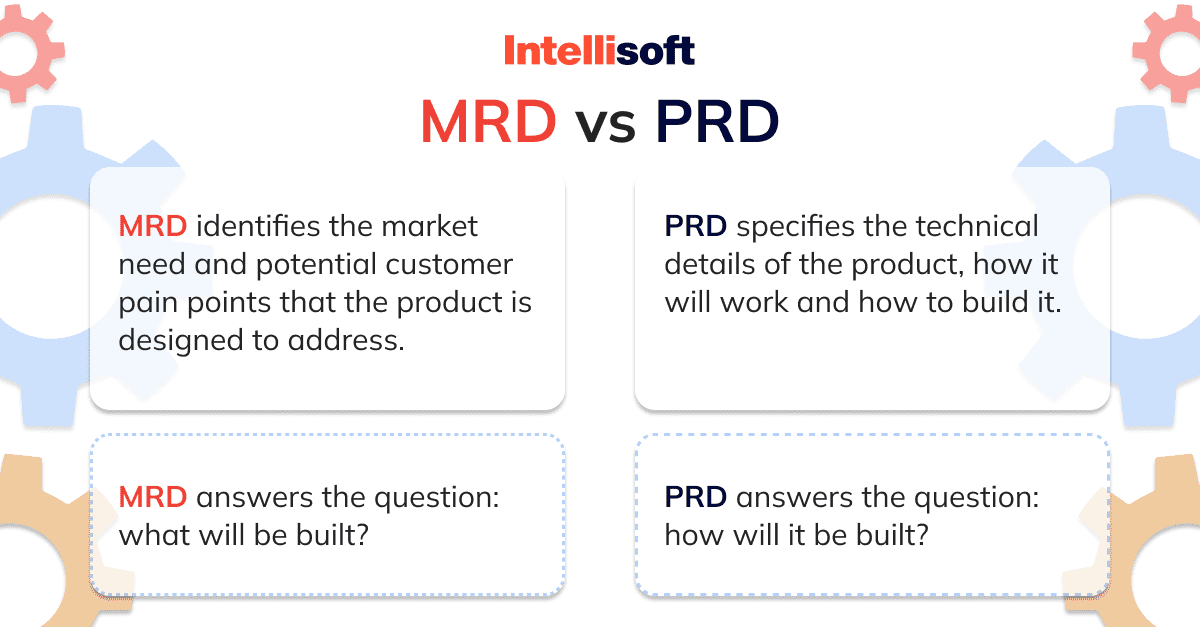
In short, PRD and MRD are two sides of the same coin. They represent the yin and yang of product development, and together they form a powerful tool for creating innovative and effective products that meet the market’s needs.
Benefits of a Lean PRD
Picture this: A team of passionate, driven individuals working together towards a common goal. The air is buzzing with excitement, the energy palpable. Everyone is aligned, focused, and pushing toward the finish line. It is the magic of a Lean PRD.
A Lean PRD is about creating the most efficient path from idea to market, focusing on speed, cost-effectiveness, and customer satisfaction.
Faster TTM (Time to Market)
One of the most significant benefits of a Lean PRD is the faster time-to-market. By streamlining the product development process, teams can quickly deliver new products and features to customers. It creates a competitive advantage and keeps customers happy by providing them with the latest and greatest offerings.
Reduced Waste
But speed isn’t the only advantage. A Lean PRD also reduces waste. By prioritizing essential features and cutting out the fluff, teams can avoid investing time and resources in features that won’t make a difference to the customer. It not only saves money but also makes the development process more sustainable.
Increased Customer Satisfaction
Speaking of customers, a Lean PRD is all about creating products that customers love. It leads to increased customer satisfaction, loyalty, and advocacy. By focusing on customer needs and desires, teams can develop products that resonate with their target audience.
Improved Collaboration
A Lean PRD requires close collaboration between all team members, from developers to designers to marketers. By breaking down silos and working together towards a common goal, teams can create a more cohesive, effective product development process.
Launch Discovery Phase For Your Project
By prioritizing speed, cost-effectiveness, customer satisfaction, and collaboration and putting it all into the PRD, you can deliver a high-quality product to the market faster than ever before.
What are the Steps in Creating a PRD?
Any project to be successful requires careful planning and preparation. Let’s look at the steps in creating a Lean Product Requirements Document.

Step 1. Identify the Problem
First, it’s essential to identify the problem the product is supposed to solve. What user problems will the product address? It is a crucial step in defining the purpose of the product and ensuring that it meets the target audience’s needs.
- Conduct User Research
Gain a deep understanding of your target audience. Identify users’ needs, pain points, and desires. You can do this through surveys, interviews, or focus groups.
- Analyze Industry Trends
It’s vital to analyze industry trends to identify emerging needs and opportunities. Look for ways your product can address these needs and provide innovative solutions.
- Review Competitors
It’s time to review your competitors’ products to identify gaps in the market. Look for areas where your product can provide unique value to the target audience.
- Analyze Customer Feedback
You can analyze feedback from your existing customers to identify common themes and areas of improvement. You can do this through customer support tickets, online reviews, or social media comments.
- Brainstorm
Work with your team to generate ideas and identify potential problems your product can solve. Encourage creative thinking and collaboration to identify new opportunities.
Step 2. Define Target User
Once you identify the problem, it’s time to define the target user. For whom is the product built? Understanding the target user’s needs, desires, and pain points is essential for creating a product that resonates with them and meets their expectations.
- Create User Personas
Use the data collected from your user research to create user personas. User personas are fictional representations of your target audience, including their goals, needs, and pain points the future product will solve.
- Consider User Scenarios
Consider how your target user will interact with your product. Identify user scenarios, such as onboarding, product use, and troubleshooting issues.
- Define User Requirements
Based on the user personas and scenarios, define the user requirements for your product. These requirements outline what the user needs from the product to achieve their goals.
- Refine Target User
Refine your target user as you continue to gather feedback and data. Use customer feedback to update user personas and requirements, ensuring that your product continues to meet the needs of your target audience.
Step 3. Create And Prioritize Feature List
Next, it’s time to create features. What are the core functionalities and parts of the product? Which ones will provide the most value to the target user? Focus on the most critical features and avoid getting bogged down in unnecessary details.
- Identify Core Features
Identify the core features of your product that are essential to its functionality. These are the features that provide the most value to your target audience.
- Categorize Features
Categorize features based on their importance and urgency. Consider the impact of each element on the user experience and the value it provides.
- Use Scoring Methods
To prioritize features, use scoring methods, such as the MoSCoW method (Must-have, Should-have, Could-have, Won’t-have). This method helps identify essential elements and those that you can add later.
- Collaborate with Stakeholders
Collaborate with stakeholders, including the development team, product managers, and designers, to prioritize features. It helps ensure everyone’s alignment on the product roadmap and underlines the correct prioritization based on the product vision and business goals.
- Consider Trade-Offs
Consider trade-offs between features, development time, cost, and impact on the user experience. Prioritize features that provide the most value to the target audience and have the highest impact on the product’s success.
Step 4. Create User Stories
Once you have identified the core features, you can create user stories. They must describe how each product feature will be used and provide a clear picture of how it will meet the target user’s needs.
- Identify User Scenarios
Identify the scenarios in which your target user will interact with your product. These scenarios can include onboarding, using the product, and troubleshooting issues.
- Define User Goals
Based on the user scenarios, define the user goals. User goals should outline what the user wants from the product in each case.
- Create User Stories
User stories must describe how users will achieve their goals using the product. Write them in a simple, concise format, such as “As a [user], I want to [goal], so that I can [benefit].”
For example, if you are working on a fitness app, your user stories could look like this:
- As a user, I want to easily log my meals and snacks to track my calorie intake and make better food choices.
- As a user, I want to be able to see a breakdown of my macronutrient intake (carbs, protein, fat) so that I can make sure I’m getting the right balance of nutrients.
- As a user, I want to be able to log my exercise so that I can track my progress and see how many calories I’m burning.
- As a user, I want to be able to set goals and see my progress toward them so that I can stay motivated and focused.
- As a user, I want to be able to connect with friends and see their progress so that I can stay accountable and motivated.
Step 5. Create the Definition Of “Done”
Creating the Definition of Done (DoD) is essential in developing a good Lean Product Requirements Document. It provides a clear and concise set of guidelines for stakeholders, developers, and QA teams to ensure that the product meets the agreed-upon requirements. The DoD defines the criteria for which a product feature or each user story is considered complete.
Here are five steps for defining your Definition of Done:
1. Get everyone on the team involved in deciding what the DoD should be
2. Create a checklist template that can be used for each feature, project, or task.
3. Be a realist and adjust expectations if perfection is not achievable
4. Break down the work into smaller pieces and create acceptance criteria for each task
5. Check your DoD against core values to ensure larger issues are addressed
Each acceptance criterion should describe a requirement that each feature or user story needs to meet before considering them done. For example, a benchmark might be that a user should be able to complete a purchase transaction in three steps or less.
How Much Will Your Project Cost?
In addition to the acceptance criteria, the DoD should also include a list of non-functional requirements that must be met, such as:
- Performance
- Security
- Usability
These non-functional requirements are critical to ensuring that the product is in a releasable state, meets the needs of its users, and performs as expected.
Once you create the DoD, all stakeholders should review and approve it. It will help ensure that everyone agrees with the definition of done and that there are clear understandings and discrepancies.
Let’s summarize all the steps. Creating a Lean PRD requires careful planning and preparation. It involves:
- Identifying the problem the product will solve
- Defining the target user
- Prioritizing features
- Creating user stories
- Outlining the definition of “done.”
These steps can create a more efficient product development process and deliver a high-quality product.
What are the Best Practices when Writing a Lean PRD?
The PRD can make or break a product’s success. It’s a delicate art form that requires the perfect balance of brevity, clarity, and specificity. So, how do you write a lean PRD that gets the job done without making your engineers want to throw themselves off a bridge? Let’s take a look at a short list of the best practices for writing a lean PRD:
- Start with a clear and concise title.
Your title should be a one-sentence summary of what the product is and what it does. Think of it as the elevator pitch of your PRD. If you can describe your product in one sentence, then it’s worth building.
- Keep it short and sweet.
The ideal length for a PRD is one page. You do it wrong if you can’t fit everything on one page. People want to avoid reading a novel-length PRD, and your engineers will thank you for keeping it short.
- Be specific.
Don’t leave any room for interpretation or assumptions. Use concrete examples and precise language to describe what the product is, what it does, and how it should behave. Engineers can’t read minds and need more time to decipher vague descriptions.
- Leave something for the future.
Try to avoid cramming every possible feature into your PRD. Instead, prioritize the most important ones and leave the rest for future versions. It will help keep your PRD lean and focused.
- Get feedback.
Before finalizing your PRD, you’d better share it with your engineers and other stakeholders for feedback. Listen to their input and make revisions as necessary. It will help ensure everyone is on the same page and that the product is feasible and realistic.
These are some of the best practices for writing a lean PRD. Remember, brevity is the soul of wit, and in the case of the PRD, it’s also the key to success.
Example of a Product Requirements Document
You know that the PRD is good when it clearly and concisely can communicate a product’s essential features and functionalities while keeping the user at the forefront of the design process.
Our specialists were responsible for the project infrastructure for proper code deployment and testing. Our development team demonstrated excellent skills when writing PRD for the ZyLAB eDiscovery project. The main achievement of the IntelliSoft crew is the successful migration of the information management legacy platform from a desktop environment based on the client’s servers into the new SaaS web-based product.
The results of our work:
- Service migration from on-premise to cloud
- Improved software efficiency through file containerization
- Reduced software dependency on the environment
- Easier deployment of new versions
- Downtime elimination
- Operation costs reduction through open-source software integration
Related readings:
- Make Your Projects Successful: Tips for Building a Powerful Project Team Structure
- Creating Technology Roadmap for the Product: Free Technology Roadmap Template
- Why Does Your Tech Startup Need a Business Plan and How to Create One?
Pros and Cons of a PRD
Typically, product managers write a PRD and then share it with the development team to guide the development process. While a PRD can be a valuable tool for ensuring that everyone is on the same page and that the product meets the desired specifications, there are also some potential drawbacks to using such a document. Let’s discuss some of the pros and cons of a PRD.
Pros:
Clarity and Consistency
A PRD provides a clear and consistent set of requirements that all stakeholders can use as a reference throughout the development process. It helps to ensure that everyone is working toward the same goals and that the final product meets the desired specifications.
Focus on User Needs
A well-written PRD should focus on the end user’s needs, which can help ensure that the final product meets their needs and is well-received in the market.
Reduced Risk of Miscommunication
By clearly outlining the requirements, a PRD can help reduce the risk of miscommunication between the product manager and development team, leading to costly delays and errors.
Better Time Management
By providing a clear set of requirements upfront, a PRD can help developers to manage their time and prioritize their tasks more effectively.
Cons:
Time and Effort
Writing a comprehensive PRD can be time-consuming and require significant effort from the product manager, which can delay the start of the development process.
Flexibility Issues
A PRD can be too prescriptive, leaving little room for the development team to be flexible and creative. It can stifle innovation and lead to a less competitive product.
Limited Scope
A PRD may only include some of the possible scenarios or edge cases that may arise during the development process, which can result in unexpected issues and additional development time.
Not Agile-Friendly
PRDs can be challenging to use in Agile development methodologies, where the focus is on rapid iteration and flexibility rather than comprehensive documentation.

It is crucial to balance the benefits of a PRD with the potential drawbacks, such as the time and effort required to create it and the risk of limiting flexibility and creativity. Ultimately, the decision to use a PRD will depend on the specific needs and goals of the project and organization.
Challenges and Solutions
Writing a Product Requirements Document can be challenging, requiring careful consideration of various factors to ensure the final product meets the desired specifications. Here are some challenges of writing a PRD and solutions to overcome them.
How to Balance Scope and Simplicity
One of the most significant challenges of writing a PRD is balancing the scope of the product with simplicity. The PRD should provide enough information to guide the development process and avoid irrelevant data to be more manageable. One solution is to use a hierarchical approach, with high-level goals and requirements at the top, followed by more detailed specifications.
How to Overcome Resistance to Change
Change can be difficult, especially for those accustomed to a particular way of doing things. To overcome resistance to change, you should ensure the PRD is user-friendly and intuitive. Testing the usability of the PRD with a diverse group of users can help identify potential issues and make adjustments as necessary.
How to Address Uncertainty in Requirements
Requirements can come from various sources, such as engineering, marketing, or customer feedback. Ensuring the traceability back to the information source can help address uncertainty and ensure all stakeholders are on the same page. Additionally, a flexible approach to requirements, such as Agile methodology, can help manage changes over time.
How to Ensure Alignment with Business Goals
The PRD should align with the overall business goals of the organization. One solution is to involve key stakeholders from different departments, such as marketing, sales, and finance, in the PRD development process to ensure alignment with the broader organizational strategy.
As you can see, by using a hierarchical approach, testing usability, ensuring traceability of requirements, and involving key stakeholders, you can overcome these challenges and make the PRD an effective tool for guiding the development of successful products.
Conclusion
That’s all we could think of about writing a Lean PRD. Let’s recap some of the benefits and best practices we’ve discussed today:
- Lean PRDs are concise, clear, and focused on the product’s essential features.
- They encourage collaboration between stakeholders and help teams stay agile and flexible.
- By incorporating feedback early and often, they reduce the risk of costly mistakes and delays.
- Best practices include involving all stakeholders in the process, keeping the document short and sweet, and staying open to changes throughout the development cycle.
You need to implement a Lean PRD in your product development process. Otherwise, you’re wasting time, money, and resources on a bloated document nobody wants to read. It’s time to get lean and mean with your PRD.
Take a long, hard look at your current PRD template. Is it working for you? Is it helping you build better products? If the answer is no, it’s time to make a change. Embrace the lean philosophy and start incorporating the best practices discussed today. Our specialists will gladly help you with that.
Remember, the goal of product development is not to create a perfect, all-encompassing document. It’s to create a successful product that meets your customers’ needs. And with a Lean PRD, you’re well on your way to achieving that goal.
AboutKosta Mitrofanskiy
I have 25 years of hands-on experience in the IT and software development industry. During this period, I helped 50+ companies to gain a technological edge across different industries. I can help you with dedicated teams, hiring stand-alone developers, developing a product design and MVP for your healthcare, logistics, or IoT projects. If you have questions concerning our cooperation or need an NDA to sign, contact info@intellisoftware.net.

